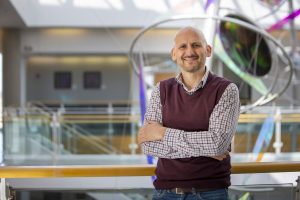Published on
Updated on
Advanced research tools help explore plant cell function and develop sustainable solutions for energy production.
Researchers at the University of Missouri have been studying plants to help farmers improve food production since the inception of the university itself, but as plants become pathways to filling other public needs — like biofuels — it opens doors to researchers who want to gain more insight into the ways that plants operate.
“All major advancements start with basic science,” said Jaime Barros-Rios, assistant professor of plant science and technology.

Barros-Rios is one of two CAFNR researchers currently working under innovative grants with the U.S. Department of Energy that allow them access to DOE equipment and laboratories to research plants that could be used in biofuel production. DOE has granted access to the Environmental Molecular Sciences Laboratory (in Washington state) and the Joint Genome Institute (in the San Francisco bay area).
“It’s an efficient way to get the best kind of sciences done,” said Steven Van Doren, professor of biochemistry and fellow DOE grantee, “and it’s a big part of the push to invest in energy and the Clean Energy Act.”
Van Doren’s project aims to better understand an enzyme that he calls “the gatekeeper” to oil synthesis — an important process if your goal is to get plants to produce more oil.

By working with the DOE, Van Doren has access to equipment, some of which is not available on-campus, like a protein synthesis machine, a machine that precisely weighs intact proteins (native mass spectrometer), and an electron microscope, which can see molecules in great detail. These tools will help him take images of the enzyme he is studying to better understand its structure and how it functions.
He explained that some of the enzymes he is studying boost the oil synthesis process while others brake the process. His goal is to use these images to identify which ones break the process and then develop the ability to prevent the break.
“In science, we don’t have manuals, so we have to go in there and explore around,” he said.
Barros-Rios is also getting a closer look at the inner workings of plant cell metabolism using highly advanced equipment available in DOE labs. For his project, he will be using a platform at EMSL that can identify thousands of proteins from just a few cells, which is particularly useful for understanding how individual cells or small populations function under different conditions. In addition, they will utilize Mass Spectrometry Imaging (MSI) to visualize the spatial distribution of molecules within plant tissues.
“If you can imagine the tip of a sharp pencil, the resolution we’ll be achieving is smaller than that,” he said of the cells he will be able to examine.
Barros-Rios will be using this information to understand how these cells control different pathways in response to stress such as drought, high light, or heat. Since these vascular cells play a central role in transporting water and nutrients, the findings could help guide genetic approaches to enhance plant resilience and adaptability to harsh environmental conditions.
For the study, he is working with sorghum, which can be used to make biofuels and bio-based materials, making it of interest to the DOE, but he emphasized that the findings for this research can be applied to other plant species, broadening our fundamental understanding of plant biology.
“The preliminary data we are gathering in the lab is promising. While it’s still early, these tools will give us the chance to test our hypotheses more rigorously,” Barros-Rios said.